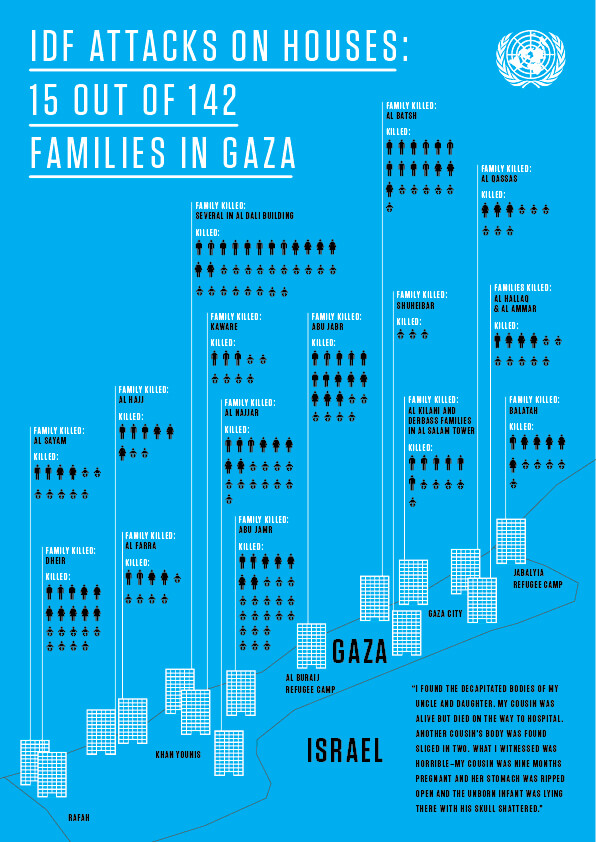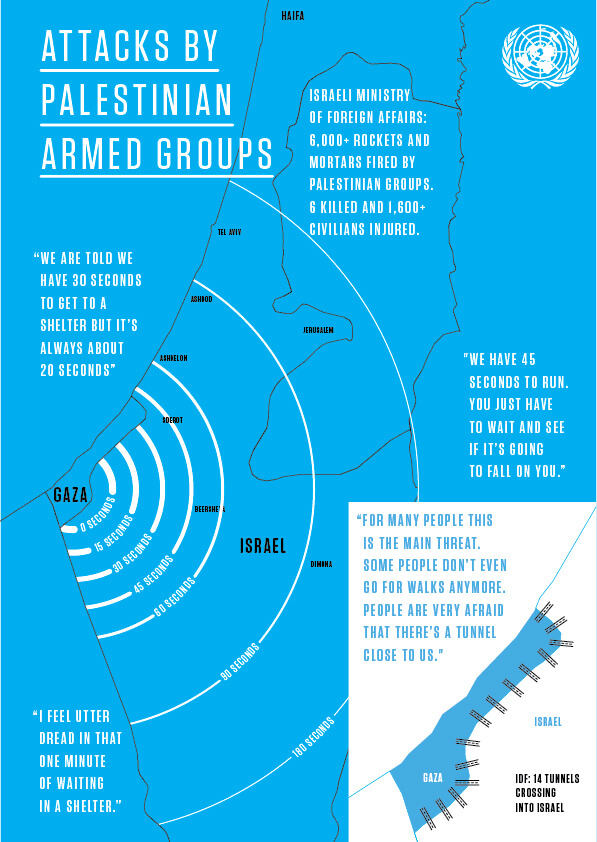The 51-day summer war between Hamas and Israel was not only “heartbreaking,” but rampant with “possible war crimes” according to a much anticipated United Nations report published Monday.

Investigators conducted nearly 300 interviews over the past year. All took place outside of Israel and the occupied Palestinian territory, as Israel denied entry to the researchers. Witnesses and victims—both Israeli and Palestinian—gave testimonies about the targeting of civilians, medical facilities and United Nations shelters, along with the existence of human shields (and the lack thereof), collective punishment, and the proportionality of the attacks.
While the bulk of the report covered alleged violations of international law conducted by Israel, Hamas too was investigated for civilian deaths resulting from rocket fire and the execution of so-called collaborators–the majority of whom were already in prison before the war. It is notable that neither authority complied with the inquiry, refusing to turn over evidence and leaving queries by monitors unanswered.
The report comes as the most definitive account of what happened during July and August in the besieged Gaza Strip during Israel’s ground invasion and air campaign. When soldiers operated inside of Gaza, journalists and human rights monitors often did not have access to the sites where the alleged violations took place. Personal safely, Israeli checkpoints inside of Gaza, and censorship from Hamas officials kept monitors at bay. Heavy bombings and fighting also made such a trip into one of Israel’s “no-go” zones impossible.
With daily death tolls ranging form 50-100 and repeated fire to shelters and schools, instances of apparent war crimes were not sufficiently investigated during the war. There was no time for follow-up to look into army orders, vet soldier testimony and find witnesses. Everyday came with new atrocities. And—often Palestinian families buried their killed relatives before any evidence of war crimes could be recorded.
Execution of civilians
A number of individual cases where civilians were seemingly executed are meticulously complied in the report. In Khuza’a the report investigated the case of Ghalia Abu Reda, a 70-year old Palestinian woman who was shot in the head. Before her killing, Israeli forces photographed the elderly Palestinian as a soldier gave her water. The image was then circulated on social media last January.
The United Nations interviewed one of Abu Reda’s relatives and found:
“When the witness returned to the family home a few days later, he found Ghalia Abu Reda’s dead body. She had a bullet mark in her head and blood on her face. The doctor who later examined the body told the witness that she had been shot from close range, from a distance of about two metres. Another member of the Abu Reda family confirmed the above allegations to the commission. That witness stated that the house was very close to the Green Line and that, some days or weeks later, an Israeli soldier posted on twitter a picture of another IDF soldier offering water to Ghalia Abu Reda:
The soldiers did this to pretend that they were human. They did not know that Gaza is small, and that the picture would be recognized by the family. When the family returned to Khuza’a they found Ghalia dead!’”
Other civilians were killed in front of witnesses. A doctor employed at Dr. Kamel Qdeih’s clinic in Khuza’a, struck on July 23rd and 24th said,
“Among them was my brother who was killed before my own eyes. He was hit during that attack and collapsed. During that same night, when I was talking to the media, I told them that although this soldier killed my brother, the most precious person for me, I would still treat him (the soldier) just as I would anybody else because he is a human being and no human being deserves to be killed. I felt so much pain. It was the most painful experience of my life, being a doctor and not being able to save my brother’s life. During that same night, I believe I saved the lives of numerous others.”
Human Shields and Detention
One of the more contentious issues of the war is human shields, where a civilian is abducted for the purpose of protecting the life of fighters or forced to carryout military duties. Israel has maintained throughout Hamas used Palestinian civilians as human shields, yet the United Nations found no evidence that this occurred. Even so, the Islamic group was condemned for not adequately protecting civilians.
Yet, there were Palestinian claims of Israelis forcing them to become human shields. A 60-year old woman from a village outside of Dier al-Balah said she was detained on July 24th and forced to become a human shield:
“The soldiers interrogated me repeatedly and detained me in the house for three days, guarding me with a gun. They did not let me use the restroom and they didn’t give me food or water. They took off my veil. I told them I was a widow from a long time and they told me that no one loved me, and that no one would ask about me if I disappeared. I was scared. I was told that I would remain with the soldiers, and I protested, telling them I was a woman and they were all men.”
Other Palestinians reported they were taken into Israeli custody and transferred to prisons inside of Israel:
“[T]he witness was taken to a small room and interrogated about tunnels and weapons caches. The witness claims to have been beaten during the interrogation. He was then given a nylon uniform to wear and transferred to another location where he spent two weeks. He was reportedly held in a room with no windows and interrogated repeatedly about the same issues. At one point, the witness claims to have been forced to sit in a small seat, which he described as being approximately 20cm x 20cm. The soldiers then placed a bag on his face, which carried a terrible stench. He stated that for three days, the soldiers would throw cold water on his head whenever he tried to sleep. The witness fell unconscious at some point and woke up several hours later, finding himself in a bigger cell with about ten other people. Finally, the witness was transferred to a court in Azabal Ashel [Eshol Prison in Beersheva], where he was sentenced to 28 days in prison. Having served his sentence, he was taken to the Erez crossing. When he asked about the 8500 shekels that had been confiscated earlier, he was told: ‘Ask Ismail Haniya.'”
A man from Khuza’a who was also detained said when soldiers took him into custody they abused his son. They “put a casserole on the boy’s head and four of them started kicking and punching him. Then one of the soldiers began shooting between the legs of the boy.”
Proportionality
Civilians were also subjected to a barrage of fire during the war. The United Nations found 44% of the Gaza strip was embattled in heavy bombing or shelling, thus dubbed a “no-go” zone, or was designated an evacuation area. An Israeli member of Knesset, Ofer Shelah, explained the scale of force in Gaza to the 2003 U.S. invasion of Iraq:
“In the first three weeks of the conquest of Iraq, in 2003, the U.S. armed forces captured cities and destroyed 1,600 armored vehicles of the Iraqi army, half of them tanks. In Gaza, the IDF fought against an enemy that had no armored vehicles, and Israeli soldiers probably saw no more than a few hundred armed Hamas militants. On average, an Israeli tank fired seven times as many shells a day as an American tank in Iraq. We fired more antitank missiles from the ground than the Americans, and twice as many Hellfire rockets from helicopters. On average, an Israeli tank fired seven times as many shells a day as an American tank in Iraq. We fired more antitank missiles from the ground than the Americans, and twice as many Hellfire rockets from helicopters.”
It was within Rafah where the war saw it’s heaviest bloodshed. Israeli forces killed 100 in a single day. A Doctor at Rafah’s al-Najjar Hospital said,
“Hundreds of people had returned to their homes because of the declaration of ceasefire. They have been unexpectedly confronted with a barrage of missiles so most of them started fleeing from the eastern parts. They were fleeing in the hundreds, on motorcycles, cars or simply on foot. Entire families, including elderly, women and children were being attacked by tanks. The attacks were indiscriminate. A lot of these attacks happened in Bildesi Street, where many of the people were fleeing. There was an explosion about every 10 seconds. During these hours, we came across hundreds of corpses that had been torn into pieces.”
Attacks on ambulances and protected humanitarian facilities

Across Gaza, 16 ambulances were “significantly damaged”, and 23 medical workers were killed. “In Rafah, all vehicles appear to have been targeted, irrespective of their civilian or military use,” the United Nation wrote. When I visited Gaza during the fighting last summer there was evidence of attacks on ambulances in plain sight. I saw two damaged ambulences, one in Shuja’iyeh destroyed to its frame. Inside it, there were two oblong piles of human flesh. Witnesses told me the ambulance was targeted directly, along with residents who came to help once the vehicle was under fire. Their remains were outside the vehicle.
Ambulances were also delayed from entering civilian areas. In Khuza’a, north of Rafah, six -year old Bader Qdeih succumbed to injuries after waiting at a checkpoint.“I don’t want to die. Don’t leave me,” he told witnesses.
Several United Nation shelters were also hit during the war. The United Nation notified the Israeli authorities on numerous occasions of their locations. On July 30th in Jabalia, a United Nations school was fired upon after its location was given 28 times to the Israeli army. Approximately 17 were killed, including three children, and 99 were injured.
“There is nowhere to be safe in Gaza. We thought that the school would be a safe place for me and my family. This was not the case. There is no way for me to get justice, I lost my husband and now I am dependent on my parents’ good will, who have limited means,” said a woman who was at the Jabalia school. Her husband was killed in the attacked and children injured.
Evidence for the ICC

While the United Nation report gives new details into the experience of war, it makes no legal ruling about the war crimes cataloged. Previously unreported instances of alleged crimes against humanity are laid out only with a suggestion of the laws they violate. The report closes recommending both Israel and the Palestinian leadership should “fully comply” with the current investigation of war crimes by the International Criminal Court. Even so, the Palestinian Authority has stated it will submit the document as evidence to The Hague in an investigation that is on-going.
Israel has immediately rejected the report’s finding. Prime Minister Netanyahu said Monday the United Nations, “has a singular obsession with Israel,” and Deputy Foreign Minister Tzipi Hotovely said “the purpose of this report was to vilify the State of Israel and the IDF [Israeli Defense Forces], with the ultimate aim of undermining Israel’s right to defend its citizens from attack.”
Conversely, the Palestinian Authority has welcomed the report and once again re-affirmed the creation of a Palestinian state along the pre-June 1967 line.
One Hamas official decried the allegations that his group committed war crimes, yet the organization as a whole released a statement Monday also lauding the report, “This clear condemnation of Israel obligates bringing its leaders to the International Criminal Court.”



Thanks so much, Allison.
Yousef Munayyer:
“Another important excerpt from UN COI report, this one on use of tunnels”
Please see: https://twitter.com/YousefMunayyer/status/612958886971219968
This report is sure not making the MSM. Nope not the report about Israeli massacres filled with hatred. How U.S. tax dollars support these massacres.
Allison Aipac has page up refuting the report
One bit of propaganda that needs shooting down is the claim that the UN focuses mostly on Israel. I visited the website of the UN Human Rights Council about an hour ago and alongside the Gaza report, they have material on Syria, North Korea, Sri Lanka, Eritrea, the group Boko Haram and probably others I’m forgetting.
But you see this all the time, thT the UN only talks about Israel.
I remember seeing WITH MY OWN LYIN’ EYES a news report back in the eighties that showed an IDF jeep driving slowly down a West Bank street with a Palestinian boy sitting on its roof.
No less a pro-Palestinian group than the Israeli courts have documented hundreds upon hundreds of cases of the IDF using Palestinian civilians as human shields. It’s documented, it is a fact. Nevertheless the imaginary human shields in Gaza or more real than the real human shields Israel uses. Go figure.
“In the first three weeks of the conquest of Iraq, in 2003, the U.S. armed forces captured cities and destroyed 1,600 armored vehicles of the Iraqi army, half of them tanks. In Gaza, the IDF fought against an enemy that had no armored vehicles, and Israeli soldiers probably saw no more than a few hundred armed Hamas militants. On average, an Israeli tank fired seven times as many shells a day as an American tank in Iraq. We fired more antitank missiles from the ground than the Americans, and twice as many Hellfire rockets from helicopters. On average, an Israeli tank fired seven times as many shells a day as an American tank in Iraq. We fired more antitank missiles from the ground than the Americans, and twice as many Hellfire rockets from helicopters.”
And one of the generals who took part in this mass slaughter and cold blooded murder said that Israeli soldiers suffered uneccessary casualties by trying to be too humane! That’s just too deranged to laugh at.
They really are a complete bunch of psickoes. And they’re working overtime making sure they suppress this (very lenient) report as much as they can. Unfortunately they’ll succeed with that task. Hardly anyone will get to know the real horrorshow truth about what they did.
Thanks Allison